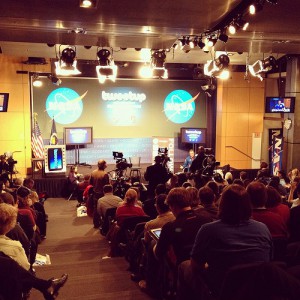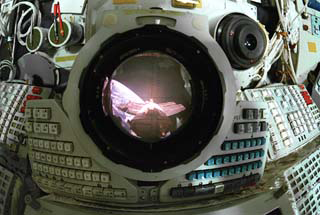
The audience waits for Astronaut Ron Garan to appear at a NASA Headquarters Tweetup in on February 15, 2012. Photo Credit: NASA/Maggie Masetti
June 29, 2012 — Vol. 5, Issue 6
Should project managers be required to have training in social media?

The audience waits for Astronaut Ron Garan to appear at a NASA Headquarters Tweetup in on February 15, 2012.
Photo Credit: NASA/Maggie Masetti
Last month I wrote that a successful complex project today depends on a strong network of people committed to its conception, design, development, implementation and conclusion. So what does this have to do with social media?
NASA’s largest projects require sustained political and societal support over a series of years. A project’s development often stretches from one presidential administration to the next. The General Accountability Office (GAO) recently did its annual assessment of selected large-scale NASA projects, and the average age of the projects surveyed in 2012 was eight years. Even the Apollo program spanned three administrations between JFK’s speech to the joint session of Congress in 1961 and the first moon landing. What this tells us is that the stakeholder base for projects has to be broad.
In the past, there were few ways to broaden that base to NASA’s ultimate stakeholder, the American public. Projects proceeded more or less out of sight until launch. That no longer has to be the case, nor should it.
Any question about the uses of social media will likely generate predictable answers from two dominant camps: people who think it represents a revolution in human communication unparalleled since Gutenberg, and those who have concluded it is mostly a waste of time. There is another way to think about it. In a world of constrained budgets, social media provide a quick, easy, and cheap way to increase openness and transparency about how work gets done at NASA, and to offer short updates about a project that will bring value to society.
The objections are easy to anticipate. NASA project managers have more important things to do than spend their time on Twitter or some other social media platform. They should be more concerned about making sure their teams can meet cost, schedule and performance parameters. Those responsibilities remain the project manager’s primary job. The question is, what else do project managers have to do today to be successful in the current environment? The simple truth is that they need to own the story of their projects.
Bill Gerstenmaier, Associate Administrator for Human Exploration and Operations, put it like this at PM Challenge 2011:
“Thats another thing that has really changed dramatically is not just the newspaper headlines, butthe blogosphere or the instant comments out there. Boy, how do you control those? And my point is I dont think you can control those. I will tell you that in the shuttle/station program, [I] used to get offended. I would I do a Flight Readiness Review, and the report would be written on what occurred during the review [before we even go out]. That made me feel kind of bad. So then I thought, well maybe Ill tell everybody, I am going to break your arms if you send any text messages or you call anyone during this review. We’re going to have total silence and then we will go talk to the press afterwards. That wasnt going to work either. Then what I decided to do is now I have PAO sit in the back of the room and they Twitter. So now I have my PAOs putting out the message during this Flight Readiness Review kind of the way I wanted. I was still on the edge a little bit. At least it is still kind of the NASA story as a review is going on, and Im actually now beating the blogs to the web. And so the message there is: instead of trying to slow down communication, again, recognize communication is diverse and fast. How can you now participate in that and use that to your advantage?
My other story that I will tell you is that I had one of my program managers whose son didnt really follow the program very much, gets an email from his son: “I see you’re getting ready to go do your presentation, good luck at the FRR.” So this guy comes up to me [and says], “How the heck did my son know that I am getting ready to go present at the Flight Readiness Review?” Then he finds out that his son was following the Flight Readiness Review on Twitter and found out his dad was there. So now I connected him and his son through Twitter in the Flight Readiness Review.
So the message there is use these things to our advantage.”
The point is not that social media is a substitute for sound project management practicesit’s that the project manager cannot afford to neglect or outsource responsibility for the project’s story. As Gerstenmaier’s story illustrates, the project manager does not have to send the tweets, just as he or she does not input changes to the master schedule. But ownership of the story begins and ends with the project manager, and the task of telling it is a continuous process that is made easier through social media. In a time where keeping a project “sold” is more critical than ever, social media is a tool that project managers cannot afford to ignore.
Listen to Bill Gerstenmaiers full presentation titled The DC Variable.








